
Associate the Plumbago
Inspiration and tips to showcase the blue of their flowers
Contents
Wonderfully coloured in blue, ranging from azure to deep cobalt blue, Plumbago, also known as Leadworts, are somewhat tender bushes. Whether it’s Plumbago auriculata (or Plumbago capensis) or its cousins, the Willmott’s Plumbago from the genus Cerastostigma, they belong to the cosmopolitan family of Plumbaginaceae. The colour of their flowering brings brightness and freshness to the landscapes in which they are associated.
In pots, in gardens with colour themes where they enhance the shades that accompany them, in rockeries or even in romantic mixed borders, discover the successful combinations where Plumbago shines: 7 ideas to pair it and highlight the azure of its flowering.
In a blue and white garden
Freshness and elegance are on the agenda in this atmosphere evoking holidays and the seaside… It can be placed by a terrace or in a patio. It doesn’t matter: a few pots and decorative elements in shades of blue and white, plants blooming in this palette of colours, and you are transported. To achieve this, combine the wonderful Plumbago auriculata or Plumbago capensis, also known as Cape Leadwort with masses of daisies from the Argyranthemum ‘Snowflake’ and its lovely white flowers that last all summer. Sow seeds of Lobelia erinus ‘Cambridge Blue’ whose small pale blue flowers will bloom all summer until the first frosts, and plant against a wall or on a support a Solanum jasminoides ‘Album’.
To complete and enrich the ensemble, you can plant the lovely Surfinia ‘Snow White’ Petunia and the lavender Lavandula intermedia ‘Grappenhall’.

In a clockwise direction around a blue and white terrace atmosphere: Plumbago auriculata, Argyranthemum ‘Snowflake’, Lobelia erinus ‘Cambridge Blue’ and Solanum jasminoides ‘Album’
In a border with southern accents
The Plumbago auriculata prefers to be grown in full sun. Evergreen in mild climates, this bush can withstand brief frosts down to -8 °C without damage. Beyond that, its survival will be compromised, and its cultivation in open ground should be reserved for privileged Mediterranean or Atlantic regions: the perfect opportunity to install it in a bed with a southern flair.
The basic framework will be provided by a planting at regular intervals of Cupressus sempervirens ‘Stricta’ or Italian Cypress and compact Oleanders (1.50 m high and 1.00 m wide) in cream-white ‘Angiolo Pucci’. Install in front of masses of Lavender angustifolia ‘Essence Purple’, with a dense and compact habit, whose long flowering will extend over several weeks from June to August. And finish with clumps of Agapanthus ‘Pitchoune Blue’, which will bloom in full sun during summer. Their ultramarine colour will beautifully complement the hue of the Plumbago, which can be trained against a south-facing wall.
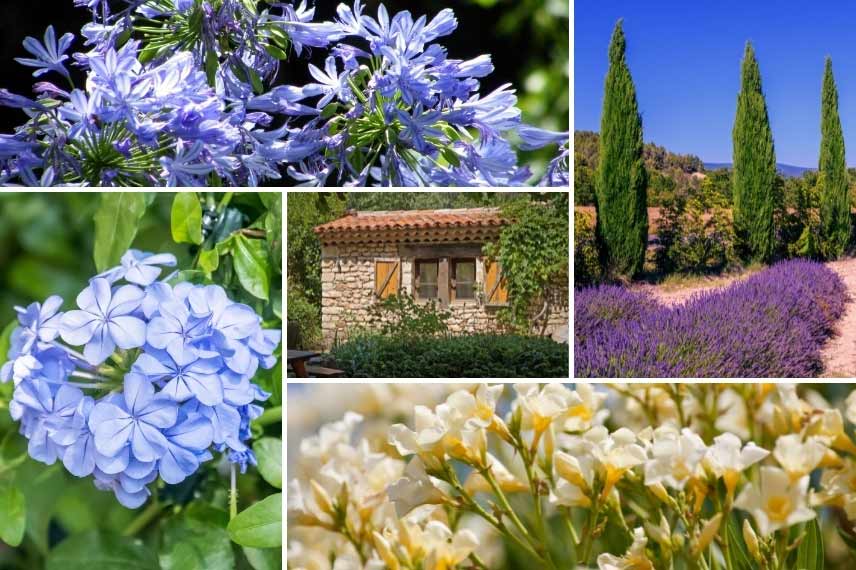
Clockwise: Agapanthus (x) africanus ‘Pitchoune Blue’, Cupressus sempervirens ‘Stricta’ and Lavandula angustifolia ‘Essence Purple’, Nerium oleander ‘Angiolo Pucci’ and Plumbago auriculata
Discover other Ceratostigma
View all →Available in 2 sizes
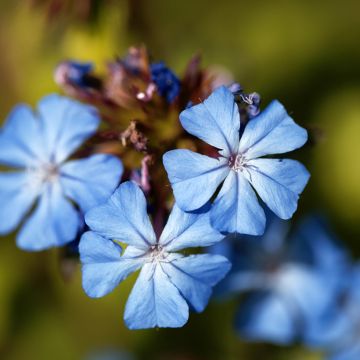
Available in 2 sizes
Available in 2 sizes
Available in 2 sizes
Available in 1 sizes
In a rockery
Sometimes referred to as Creeping Plumbago, the Ceratostigma plumbaginoides will thrive in a rockery, where it will colonise the space with its running rootstock. This creeping undershrub will provide a long bright blue flowering display at the end of summer, contrasting with its foliage that turns purple from September. It thus adds real appeal to the late season. The Creeping Plumbago is a robust and hardy groundcover that withstands drought extremely well. Planted in a rockery or on a slope with poor soil, it will pair beautifully with Euphorbias such as Euphorbia seguieriana ssp. niciciana or Siberian Spurge, which flowers in acid green from June to September.
Add Opuntia or prickly pear cacti to bring lovely grey-green foliage, height, and volume to this rockery, along with clumps of the little-known Achillea taygetea that will form small, upright, compact bushes, dotted with umbel-shaped light lemon-yellow flowers throughout the summer. Finally, as a complementary groundcover to Ceratostigma plumbaginoides, plant grey carpets of Mouse Ears Cerastium tomentosum ‘Yo Yo’, a particularly floriferous cultivar covered in white flowers from May to July.

Euphorbia seguieriana ssp. niciciana, Opuntia, Ceratostigma plumbaginoides, Achillea taygetea and Cerastium tomentosum ‘Yo Yo’
On a living wall
Called not long ago “Plumbago capensis“, Plumbago auriculata is a semi-climbing and semi-shrubby plant with flexible stems. Also known as Cape Leadwort, it quickly reaches a height of about 3 m and a spread of 2.50 m in the ground. It can therefore be trained on a support such as a trellis or fence, helping to green and flower walls.
If you live in a region with a favourable climate that experiences little frost and you wish to cover the facades of a home, green a courtyard or patio, you can combine Plumbago, which will be adorned with clusters of azure blue flowers from July to October, with other climbers. Consider the False Jasmine Trachelospermum jasminoides, Heavenly Blue Ipomoeas, and Bougainvillea ‘Violet de Mèze’. The flowering of these climbing plants, suited to Mediterranean regions and the Atlantic coast, will follow in a joyful and dynamic palette of blue, pink, and white.

Plumbago auriculata, Trachelospermum jasminoides, Heavenly Blue Ipomoea, and Bougainvillea ‘Violet de Mèze’
In a mixed border with soft hues
The mixed border takes the form of a wide flowerbed, blending blooms in a harmony of colours and natural habits. For a display with soft hues against a wall, plant the Plumbago auriculata trained against it or formed on a stem. Plant the Erigeron ‘Schwarzes Meer’ with blue-violet flowers in June-July. Add the old rose with soft pink flowers ‘Mme Boll’, vigorous, very repeat flowering, and wonderfully fragrant, along with the pink lavender Lavandula angustifolia ‘Rosea’. If you need to add verticality and cover a wall, consider the clematis ‘Will Goodwin’ in lavender mauve.

Plumbago auriculata on a stem, creating a mixed border atmosphere with soft hues, including Erigeron ‘Schwarzes Meer’, old rose, and Lavandula angustifolia ‘Rosea’
In a two-colour bed
Also known as “Willmott’s Plumbago”, the Ceratostigma willmottianum ‘Sapphire Ring’ is a small bush with a soft habit of about 70 cm in height and width. It offers a superb and long-lasting cobalt blue flowering that beautifully contrasts with its golden foliage. It will look stunning in a warm, sheltered position within a bicolour bed that naturally reflects its hues: blue and yellow.
The double-flowered large Coreopsis Coreopsis grandiflora ‘Louis d’Or’ with its very bright golden yellow pompom flowers will bring a true note of cheerfulness to this composition, tempered by the lavender blue of the Perovskia atriplicifolia ‘Blue Spire’. Wonderfully aromatic, this Afghan Sage will bloom from June to September over generous grey-green foliage. The silver-grey clumps of Wormwood Artemisia absinthium will quickly add volume and elegance to this easy-to-cultivate and maintain bed.

Ceratostigma willmottianum ‘Sapphire Ring’, Coreopsis grandiflora ‘Louis d’Or’, Perovskia atriplicifolia ‘Blue Spire’ and Artemisia absinthium
In a pot on the terrace
The cultivation of Plumbago is not reserved solely for gardeners on the southern or Atlantic coast. If you don’t want to resist the temptation of its wonderful flowering and the generosity of its foliage, install it in a pot. Ensure you have a sufficiently large container to guarantee its development and stake or train it against a support. The key is to be able to winter it in a frost-free environment for a few months each year, in a cool and bright room.
You can thus pair Plumbago auriculata with other tender plants that will also be kept frost-free during winter. For a decidedly exotic look, consider the Papyrus Cyperus alternifolius, generous and fast-growing, which you can cultivate indoors during the cold season. Place it in a pot without drainage holes at the bottom and ensure its root ball remains consistently moist. Plant a mini-palm Cycas revoluta in a beautiful terracotta pot, positioning it in full sun. And to add some floral charm, place pots filled with Agapanthus ‘Silver Moon’, true collection perennials distinguished by their bright variegated foliage. They are adorned in June-July with numerous blue-violet umbels that create a stunning effect.
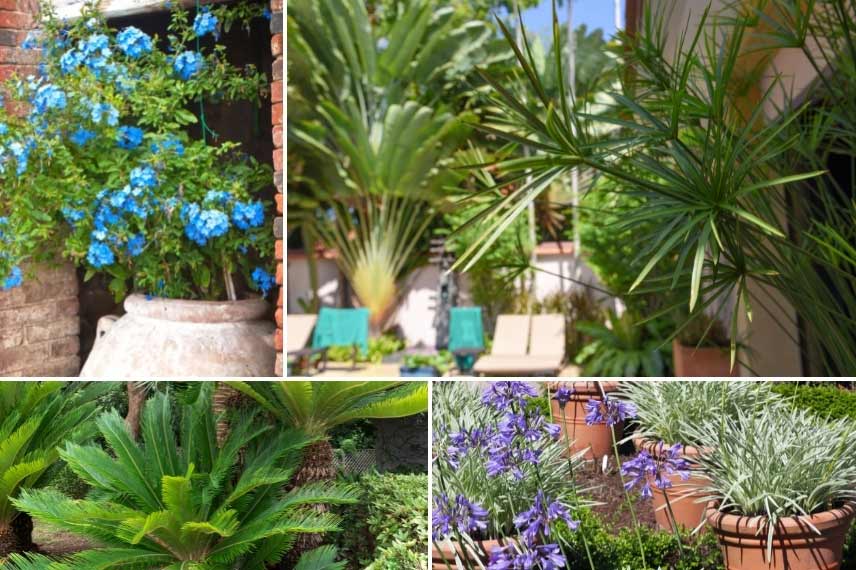
Plumbago auriculata, Cyperus alternifolius, Cycas revoluta and Agapanthus ‘Silver Moon’
- Subscribe!
- Contents
































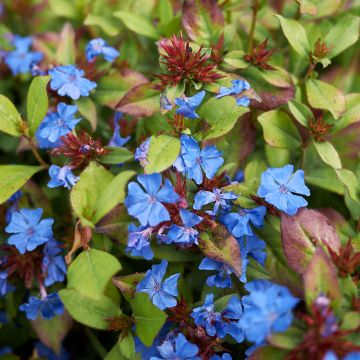
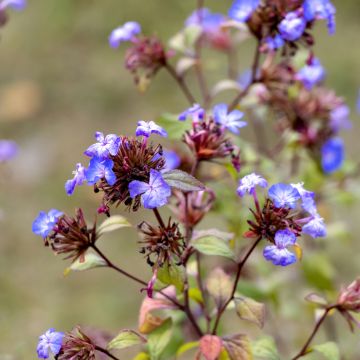
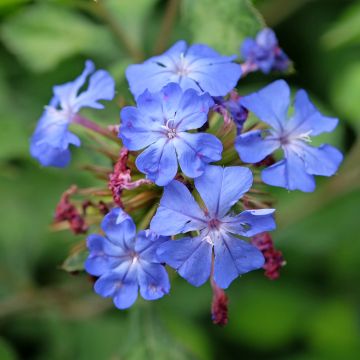

Comments